Traveling from Spain to Morocco is a popular adventure, offering a unique blend of European and African cultures. At SIXT.VN, we provide seamless travel solutions to make your journey unforgettable. Whether you prefer a scenic ferry ride or a quick flight, we’ll guide you through the best options and help you navigate the details, so you can experience the best of both worlds. With our reliable services, you can explore vibrant cities and stunning landscapes effortlessly.
1. Can You Travel From Spain to Morocco?
Yes, you absolutely can travel from Spain to Morocco. This journey is a well-trodden path for tourists and locals alike, thanks to the close proximity of the two countries. According to the Tourism Review, Morocco recorded 14.5 million tourist arrivals in 2023, indicating its popularity as a travel destination. Whether you’re drawn by Morocco’s rich history, bustling markets, or stunning landscapes, traveling from Spain is a convenient way to start your adventure.
1.1. Passport and Visa Requirements
Most nationalities, including those from the USA, EU, Australia, and Canada, can enter Morocco without a visa for tourism purposes, provided your stay is less than 90 days. However, ensure your passport is valid for at least three months beyond your intended stay. It’s always best to check the specific requirements for your nationality on the official website of the Moroccan embassy or consulate in your country. For up-to-date information, refer to the Moroccan Ministry of Foreign Affairs.
1.2. Health and Safety
Before traveling, consult your doctor about necessary vaccinations and health precautions. Common recommendations include vaccinations for Hepatitis A and Typhoid, as noted by the Centers for Disease Control and Prevention (CDC). Morocco is generally a safe country, but it’s wise to stay informed about local conditions and follow standard safety precautions to ensure a smooth trip.
2. What Are the Best Ways to Travel from Spain to Morocco?
There are primarily two ways to travel from Spain to Morocco: by ferry or by flight. Each option has its own set of advantages and considerations.
2.1. Traveling by Ferry
The ferry is a popular choice for those who want to bring a vehicle or enjoy a scenic journey. Several ferry routes connect Spain and Morocco, with the most common being from Tarifa or Algeciras in Spain to Tangier or Tangier Med in Morocco.
2.1.1. Popular Ferry Routes
- Tarifa to Tangier Ville: This is the shortest and often the most convenient route, taking about 1 hour. According to ferry operator FRS, this route offers multiple daily departures.
- Algeciras to Tangier Med: This route takes about 1.5 to 2 hours and is serviced by multiple ferry companies.
- Barcelona to Tangier Med: A longer route, typically taking around 26 to 28 hours, ideal for those who prefer a leisurely voyage.
2.1.2. Benefits of Ferry Travel
- Bringing a Vehicle: The ferry allows you to bring your car, motorcycle, or campervan, offering flexibility to explore Morocco at your own pace.
- Cost-Effective: For families or groups, the ferry can be more economical than flying, especially when considering luggage costs and rental car fees.
- Scenic Views: Enjoy stunning views of the Strait of Gibraltar and the coastlines of both Spain and Morocco.
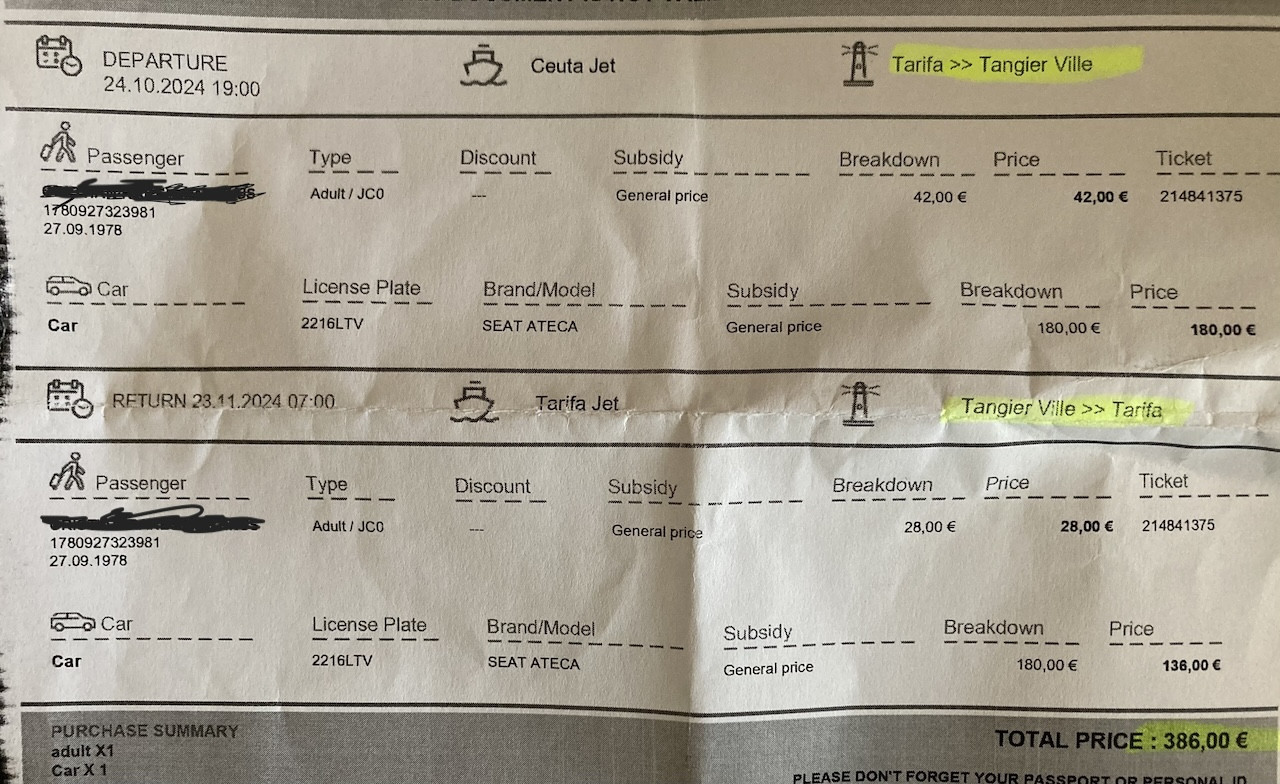 Ferry Ticket
Ferry Ticket
2.1.3. Tips for Ferry Travel
- Book in Advance: Especially during peak season, book your ferry tickets in advance to secure your preferred departure time and avoid higher prices.
- Arrive Early: Arrive at the ferry terminal at least 1 to 2 hours before departure to allow time for check-in and customs procedures.
- Check the Weather: Ferry schedules can be affected by bad weather, so check the forecast and be prepared for potential delays.
2.2. Traveling by Flight
Flying is the quickest way to travel from Spain to Morocco, especially if you’re short on time. Several airlines offer direct flights from major Spanish cities to Moroccan destinations.
2.2.1. Popular Flight Routes
- Madrid to Marrakech: A direct flight typically takes around 1.5 to 2 hours.
- Barcelona to Casablanca: Direct flights are available, usually lasting about 2 hours.
- Seville to Tangier: A short flight of approximately 1 hour.
2.2.2. Benefits of Air Travel
- Time-Saving: Flying is significantly faster than the ferry, making it ideal for short trips.
- Convenience: Airports are often located near major cities, offering easy access to accommodation and transportation.
- Comfort: Enjoy a comfortable and hassle-free journey with in-flight services.
2.2.3. Tips for Air Travel
- Compare Prices: Use online comparison tools to find the best flight deals. Websites like Skyscanner and Google Flights can help you find affordable options.
- Check Baggage Allowances: Be aware of baggage restrictions and fees, especially if traveling with budget airlines.
- Book in Advance: Booking flights in advance can often result in lower fares, particularly during peak travel times.
3. What to Expect When Arriving in Morocco
Arriving in Morocco, whether by ferry or flight, involves several steps. Understanding these procedures can help you navigate the process smoothly.
3.1. Immigration and Customs
- Entry Form: Before disembarking the ferry or plane, you’ll need to fill out an entry form. This form requires basic personal information and travel details.
- Passport Control: Present your passport and completed entry form to the immigration officer. Ensure your passport is stamped with the date and entry number.
- Customs: Declare any goods that may be subject to customs duties. Generally, personal belongings are exempt.
3.2. Transportation from Ports and Airports
- Taxis: Taxis are readily available at ports and airports. Agree on a fare before starting your journey to avoid overcharging.
- Rental Cars: If you plan to rent a car, arrange it in advance for pickup at the port or airport. SIXT.VN offers convenient rental car services to suit your needs.
- Public Transportation: Some cities offer bus or train services from the port or airport to the city center.
3.3. Currency and Communication
- Currency: The official currency of Morocco is the Moroccan Dirham (MAD). Exchange currency at the airport or in major cities for the best rates.
- Communication: Arabic and French are the official languages of Morocco. English is also widely spoken in tourist areas. Consider purchasing a local SIM card for affordable mobile data and calls.
4. Top Destinations to Visit in Morocco
Morocco offers a diverse range of attractions, from ancient cities to stunning natural landscapes. Here are some top destinations to consider:
4.1. Marrakech
Marrakech is a vibrant city known for its bustling souks, stunning palaces, and lively atmosphere.
- Must-See Attractions: Jemaa el-Fnaa, Bahia Palace, Saadian Tombs, and Jardin Majorelle.
- Activities: Explore the Medina, take a cooking class, and enjoy a traditional Hammam.
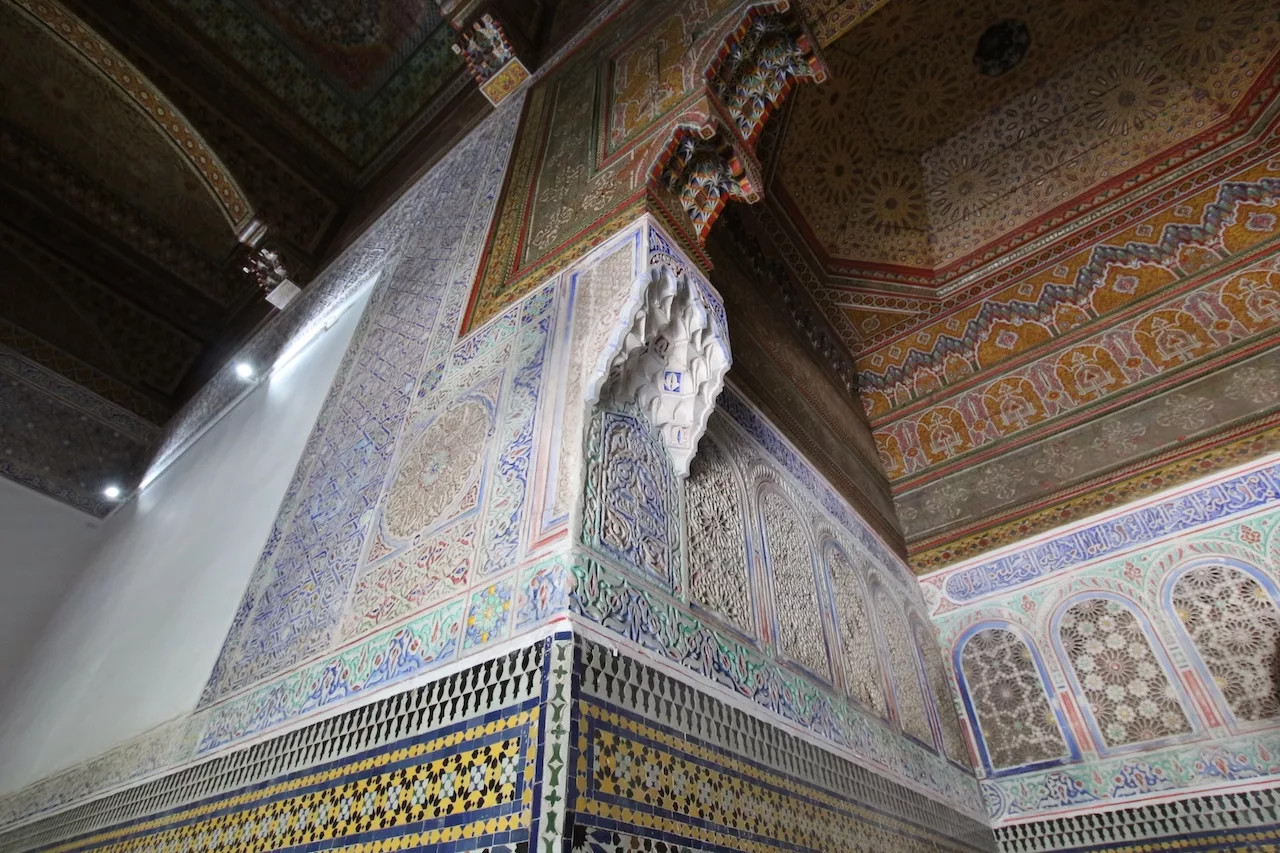 Dar el Bacha palace Marrakech 2023 jpg
Dar el Bacha palace Marrakech 2023 jpg
4.2. Fes
Fes is the cultural heart of Morocco, famous for its well-preserved medieval Medina and traditional crafts.
- Must-See Attractions: Fes el Bali (Old City), Al-Attarine Madrasa, Chouara Tanneries, and the Royal Palace.
- Activities: Wander through the labyrinthine streets of the Medina, visit the tanneries, and shop for local handicrafts.
4.3. Chefchaouen
Chefchaouen, also known as the “Blue Pearl,” is a picturesque town nestled in the Rif Mountains, famous for its blue-washed buildings.
- Must-See Attractions: The Medina, Grand Mosque, and the Spanish Mosque.
- Activities: Hike in the Rif Mountains, explore the local markets, and enjoy the tranquil atmosphere.
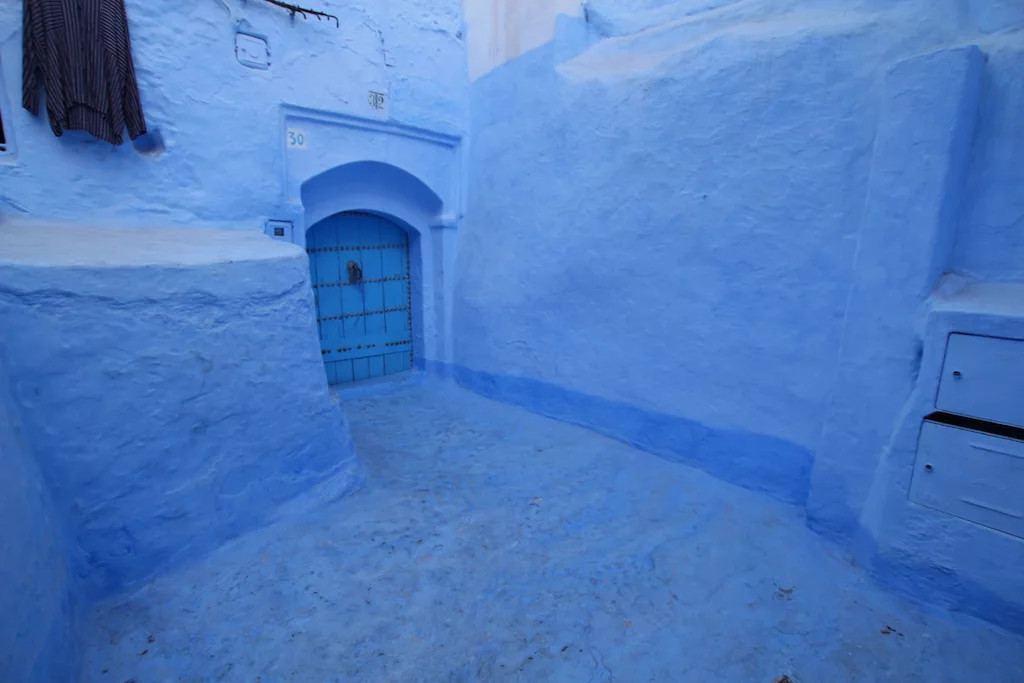 Chefchaouen street and door 2017
Chefchaouen street and door 2017
4.4. Sahara Desert
A visit to the Sahara Desert is a must for an unforgettable Moroccan experience.
- Activities: Camel trekking, desert camping, sandboarding, and stargazing.
- Recommended Tours: Merzouga and Erg Chebbi are popular destinations for desert tours.
4.5. Tangier
Tangier, a port city, offers a mix of cultures and a rich history, with influences from Europe and Africa.
- Must-See Attractions: The Kasbah, the Medina, the American Legation Museum, and the Caves of Hercules.
- Activities: Explore the historic sites, relax on the beaches, and enjoy the city’s vibrant nightlife.
5. Planning Your Trip: Essential Tips
Planning your trip from Spain to Morocco requires careful consideration of several factors to ensure a smooth and enjoyable experience.
5.1. Best Time to Visit
The best time to visit Morocco is during the spring (April to May) or autumn (September to November). The weather is mild, and the tourist crowds are smaller compared to the summer months. According to the Moroccan National Tourist Office, these months offer the most pleasant climate for exploring the country.
5.2. Accommodation Options
Morocco offers a wide range of accommodation options to suit different budgets and preferences.
- Riads: Traditional Moroccan houses with interior courtyards, offering a unique and authentic experience.
- Hotels: Ranging from budget-friendly to luxury, hotels provide standard amenities and services.
- Guesthouses: Smaller and more intimate than hotels, guesthouses offer a personal touch and local hospitality.
- Camping: In the Sahara Desert, camping is a popular option for experiencing the wilderness.
5.3. Cultural Considerations
Respecting local customs and traditions is essential for a positive travel experience in Morocco.
- Dress Modestly: Dress conservatively, especially when visiting religious sites or rural areas.
- Learn Basic Arabic Phrases: Knowing a few basic Arabic phrases can enhance your interactions with locals.
- Bargaining: Bargaining is a common practice in the souks, so be prepared to negotiate prices.
- Ramadan: If traveling during Ramadan, be aware that many businesses may have reduced hours, and eating and drinking in public during daylight hours is prohibited.
5.4. Staying Connected with SIXT.VN
SIXT.VN can enhance your travel experience in Morocco by providing various services:
- Airport Transfers: Start your trip stress-free with reliable airport transfer services from SIXT.VN.
- Car Rentals: Explore Morocco at your own pace with a rental car from SIXT.VN, offering a wide selection of vehicles to suit your needs.
- Travel Packages: Consider SIXT.VN’s travel packages, which can include flights, accommodation, and tours for a hassle-free experience.
6. Addressing Common Concerns
Many travelers have questions and concerns when planning a trip from Spain to Morocco. Here are some answers to common queries:
6.1. Is it Safe to Travel to Morocco?
Morocco is generally a safe country for tourists. However, like any travel destination, it’s essential to take precautions.
- Stay Informed: Keep up-to-date with the latest travel advisories from your government.
- Secure Your Belongings: Be aware of your surroundings and protect your belongings from theft, especially in crowded areas.
- Trustworthy Transportation: Use licensed taxis or reputable car rental services like SIXT.VN to ensure safe transportation.
6.2. What are the Visa Requirements for Morocco?
Most nationalities, including those from the USA, EU, Australia, and Canada, do not require a visa for tourism purposes for stays up to 90 days. Always check the latest requirements on the official website of the Moroccan embassy or consulate in your country.
6.3. What is the Best Way to Get Around in Morocco?
- Rental Cars: Renting a car provides flexibility for exploring the country at your own pace. SIXT.VN offers a variety of rental options.
- Trains: Morocco’s rail network connects major cities like Casablanca, Marrakech, and Fes.
- Buses: Buses are a cost-effective way to travel between cities, especially for longer distances.
- Taxis: Taxis are readily available in cities for short trips.
6.4. What Should I Pack for a Trip to Morocco?
- Clothing: Pack lightweight, breathable clothing suitable for warm weather. Include modest attire for visiting religious sites.
- Footwear: Comfortable walking shoes are essential for exploring cities and hiking.
- Sun Protection: Sunscreen, sunglasses, and a hat are crucial for protecting yourself from the sun.
- Medications: Bring any necessary medications, along with a copy of your prescription.
6.5. What is the Local Cuisine Like?
Moroccan cuisine is rich and flavorful, with influences from Berber, Arab, and French culinary traditions.
- Tagine: A slow-cooked stew with meat, vegetables, and spices.
- Couscous: Steamed semolina served with meat and vegetables.
- Pastilla: A savory-sweet pie filled with pigeon or chicken, almonds, and spices.
- Mint Tea: A traditional Moroccan beverage served with fresh mint and sugar.
7. Day Trip from Spain to Morocco: Is It Worth It?
Taking a day trip from Spain to Morocco can be a unique experience. Here are some considerations:
7.1. Potential Benefits:
- Experience a New Culture: Even a brief visit allows you to sample Moroccan culture, cuisine, and architecture.
- Proximity: The short ferry ride from Tarifa to Tangier makes a day trip feasible.
- Bragging Rights: You can say you’ve set foot on African soil.
7.2. Potential Drawbacks:
- Limited Time: A day trip offers only a superficial glimpse of Morocco.
- Travel Time: Much of your day will be spent traveling, leaving less time for exploration.
- Tangier as a Starting Point: Tangier, while interesting, isn’t necessarily the best representation of Morocco.
7.3. Maximizing a Day Trip:
- Plan Ahead: Book your ferry tickets in advance and research the sights you want to see.
- Hire a Guide: Consider hiring a local guide in Tangier to make the most of your limited time.
- Focus on Key Sights: Prioritize the most important sights, such as the Kasbah and the Medina.
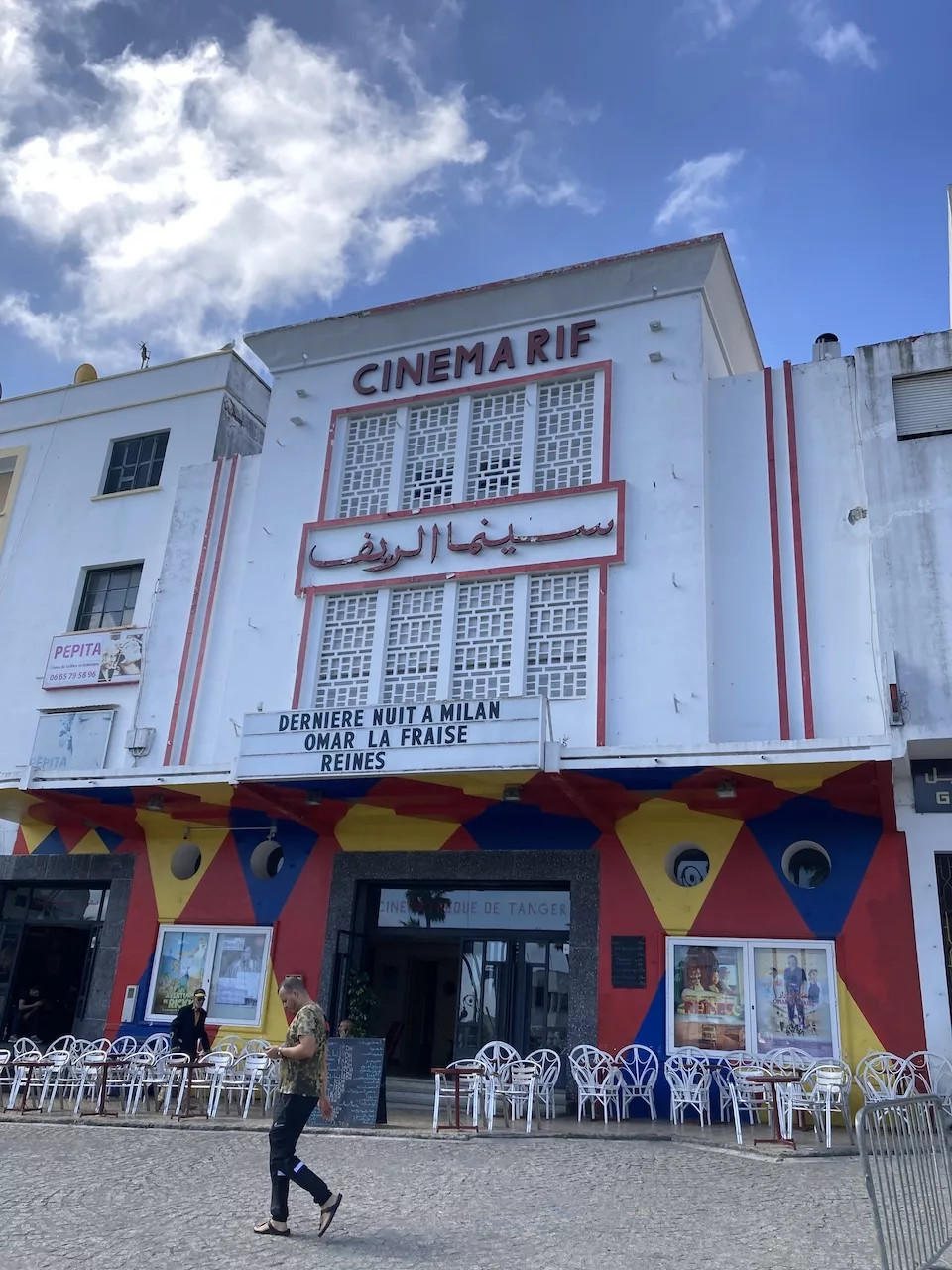 Cinema Rif in Tangiers 2023
Cinema Rif in Tangiers 2023
8. Bringing a Vehicle from Spain to Morocco:
Bringing your vehicle from Spain to Morocco via ferry offers flexibility but comes with its own set of considerations:
8.1. Cost:
- Ferry Costs: Ferrying a vehicle can be significantly more expensive than passenger tickets alone, potentially costing around 500 euros (550 USD) for a round trip.
- Importation Taxes: Be aware of potential temporary importation taxes or fees for your vehicle.
8.2. Paperwork and Customs:
- Vehicle Registration: Ensure your vehicle registration and insurance are valid and up to date.
- Customs Declarations: Be prepared to complete customs declarations for your vehicle upon arrival in Morocco.
8.3. Driving in Morocco:
- Road Conditions: Road conditions in Morocco can vary, with some rural roads being less well-maintained.
- Driving Style: Be prepared for a more assertive driving style than you may be accustomed to.
- Parking: Parking can be challenging in urban areas, so plan accordingly.
8.4. Alternatives:
- Renting a Car: Renting a car in Morocco might be more convenient and cost-effective, especially for shorter trips. SIXT.VN offers rental services in Morocco.
- Public Transportation: Morocco has a reasonably good public transportation system, including trains and buses.
9. Traveling from Morocco to Spain:
The journey from Morocco to Spain is similar to the reverse, but here are some specific considerations:
9.1. Ferry Routes:
- Tangier Ville to Tarifa: This is often the most convenient route.
- Tangier Med to Algeciras: Another popular option with frequent departures.
9.2. Customs and Immigration:
- Exit Procedures: Be prepared for exit customs and immigration procedures in Morocco.
- Entry Requirements: Ensure you meet the entry requirements for Spain or the Schengen Area.
9.3. Transportation from Tarifa:
- Buses: Regular buses run from Algeciras (a 30-minute drive from Tarifa) to other destinations in Spain.
- Car Rentals: You can rent a car in Tarifa or Algeciras to explore the region. SIXT.VN provides rental options.
- Ride Sharing: Services like BlablaCar are popular for car sharing in Spain.
9.4. Planning Your Stay:
- Accommodation: Consider spending a night in Tarifa or nearby towns like Cadiz or Arcos de la Frontera.
- Sightseeing: Tarifa has a charming historical center, and the surrounding area offers beautiful beaches and natural parks.
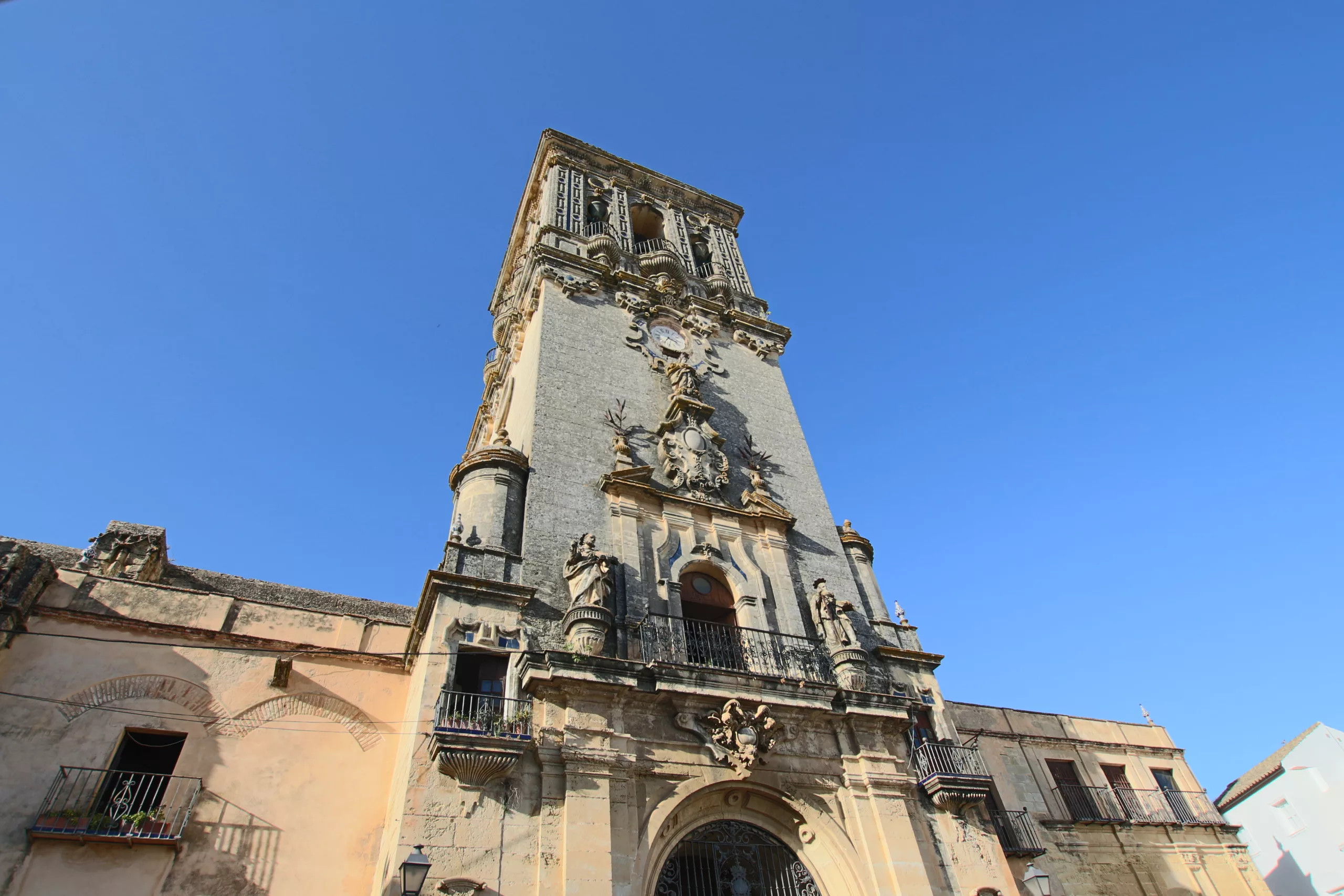 arcos de la frontera 2017 main square
arcos de la frontera 2017 main square
10. Why Choose SIXT.VN for Your Trip?
SIXT.VN offers a range of services designed to make your trip from Spain to Morocco as smooth and enjoyable as possible.
10.1. Convenience:
- One-Stop Shop: From airport transfers to car rentals and travel packages, SIXT.VN provides comprehensive travel solutions.
- Easy Booking: Book your services online or through our mobile app, saving you time and effort.
- 24/7 Support: Our customer support team is available 24/7 to assist you with any questions or concerns.
10.2. Reliability:
- Trusted Provider: SIXT.VN is a reputable and trusted travel service provider.
- Quality Vehicles: Our rental cars are well-maintained and come with comprehensive insurance options.
- Professional Drivers: Our airport transfer services use experienced and professional drivers.
10.3. Value:
- Competitive Prices: We offer competitive prices on all our services, ensuring you get the best value for your money.
- Special Offers: Take advantage of our special offers and discounts to save even more on your trip.
- Customized Packages: We can create customized travel packages tailored to your specific needs and preferences.
Traveling from Spain to Morocco can be an enriching and rewarding experience. Whether you’re drawn to the bustling cities, stunning landscapes, or vibrant culture, careful planning and the right support can make your trip unforgettable. With SIXT.VN, you can enjoy a seamless and hassle-free journey, allowing you to focus on creating lasting memories.
Ready to embark on your adventure? Visit SIXT.VN today to book your airport transfer, car rental, or travel package, and let us help you make your dream trip a reality! Address: 260 Cau Giay, Hanoi, Vietnam. Hotline/Whatsapp: +84 986 244 358. Website: SIXT.VN.
FAQ: Traveling from Spain to Morocco
-
Do I need a visa to travel from Spain to Morocco?
Most nationalities, including those from the USA, EU, Australia, and Canada, do not require a visa for tourism purposes for stays up to 90 days. Always check the latest requirements on the official website of the Moroccan embassy or consulate in your country.
-
What is the best way to travel from Spain to Morocco?
The best way to travel depends on your preferences and budget. The ferry is a scenic option and allows you to bring a vehicle, while flying is faster and more convenient for short trips.
-
How long does the ferry take from Spain to Morocco?
The ferry from Tarifa to Tangier Ville takes about 1 hour, while the ferry from Algeciras to Tangier Med takes about 1.5 to 2 hours.
-
Can I take a day trip from Spain to Morocco?
Yes, you can take a day trip from Spain to Morocco, especially from Tarifa to Tangier. However, be prepared for limited time and focus on key sights.
-
Is it safe to travel to Morocco?
Morocco is generally a safe country for tourists. However, it’s essential to take precautions and stay informed about local conditions.
-
What currency is used in Morocco?
The official currency of Morocco is the Moroccan Dirham (MAD).
-
What language is spoken in Morocco?
Arabic and French are the official languages of Morocco. English is also widely spoken in tourist areas.
-
What should I pack for a trip to Morocco?
Pack lightweight, breathable clothing, comfortable walking shoes, sunscreen, sunglasses, and a hat. Also, consider modest attire for visiting religious sites.
-
Can I rent a car in Morocco?
Yes, you can rent a car in Morocco. SIXT.VN offers a variety of rental options to suit your needs.
-
What are some must-see attractions in Morocco?
Some must-see attractions include Marrakech’s Jemaa el-Fnaa, Fes el Bali (Old City), Chefchaouen’s Medina, and the Sahara Desert.



